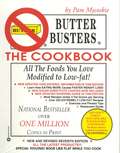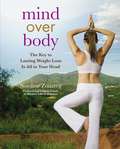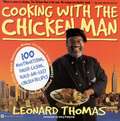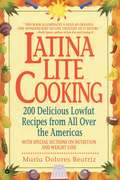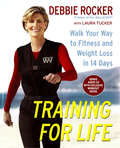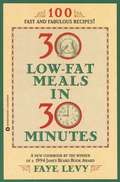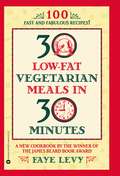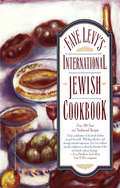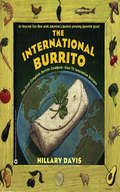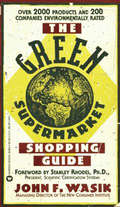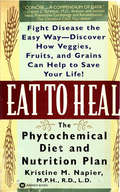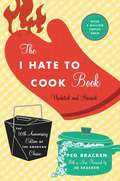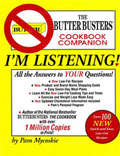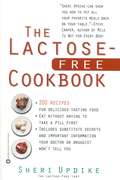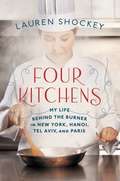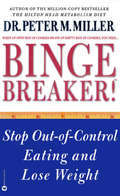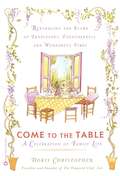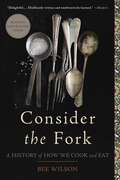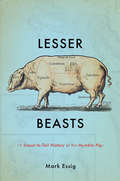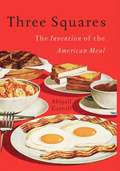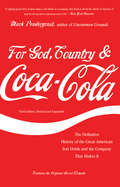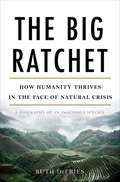- Table View
- List View
Butter Busters: The Cookbook
by Pam MycoskieA phenomenal, self-published bestseller--now completely revised and updated. This revolutionary new book contains over 350 delicious recipes that use simple substitutions to transform family favorites into very low-fat, healthy foods. Recipes for cakes, cookies, pies, lasagna, pizza, and other dishes.
Mind Over Body: The Key to Lasting Weight Loss Is All in Your Head
by Nordine ZouaregThe true secret to weight-loss success is all in your head. Nordine Zouareg has helped thousands of clients get healthier, be happier, and lose weight for good. And in the process, he's discovered something astounding: the mental work his clients do before they start their diet and exercise plan is actually just as (if not more) important than the plan itself. In Mind Over Body, Nordine describes how everyone can find this mental motivation -- what he calls our "core desire" -- and then master the tools (visualization, meditation, affirmation) to keep on track with weight-loss goals. After readers develop this foundation, they move on to the inspiring nutrition and exercise plan--a simple, effective program developed to help shed weight and keep it off forever. You'll learn: The fool-proof method for preparing your mind -- and your body -- before you diet Thirty delicious foods that are the staples of the Mind Over Body eating plan When to cheat -- without blowing your diet How to get an effective workout in just 24 minutes a day The 10 commandments of mindful strength training As the fitness coach at Miraval Life in Balance spa, Nordine has worked with celebrities, business leaders, discerning travelers, and soccer moms all across North America. Rated the #1 spa by Conde Nast Traveler, the #1 destination spa by Travel and Leisure, and the top spa in American by Zagat, Miraval has become the premier destination for bringing people?s lives into balance and teaching them how to live mindfully. Now, in Mind Over Body, Nordine teaches the same program that has proven wildly successful for his clients (and himself!) for the past twenty years. Learn how to determine your true fitness goals...and get the tools you need to finally make it come true!
Cooking with the Chicken Man
by Leonard ThomasFrom radio commentator, drawbridge operator, and master chicken chef Leonard "The Chicken Man" Thomas comes a collection of cooking tips and 100 recipes--plus the funniest chicken stories on the planet! Photos and illustrations.
Latina Lite Cooking: 200 Delicious Lowfat Recipes From All Over The Americas - With Special Selections On Nutrition And Weight Loss
by Maria Dolores BeatrizEntertaining, practical, and informative, "Latina Lite Cooking" provides 200 recipes for low-fat yet delicious fare from the cuisines of Mexico, Puerto Rico, Cuba, Spain, and all of Latin America, plus the author's state-of-the-art weight reduction plan and her unique message of self-empowerment.A.
Training for Life: Walk Your Way to Fitness and Weight Loss in 14 Days
by Debbie Rocker Laura TuckerIn this engaging, easy-to-follow fitness book, celebrity fitness trainer Debbie Rocker shows readers how to use walking -- the body's most natural form of exercise -- to achieve total transformation in a mere two weeks.Celebrity fitness trainer Debbie Rocker is one of the original developers of Spinning, the international fitness phenomenon, and a world record holder in cycling. In Training for Life, she presents her personalized fitness philosophy in a 14-day program that includes walking basics, dietary recommendations, and additional upper body workouts that tone muscles, build bone density, and speed weight loss.Readers will discover how they can build confidence, attain total fitness, and train their minds to think of exercise and proper nutrition as fulfilling parts of life.
30 Low-Fat Meals in 30 Minutes
by Faye LevyThis book will prove that you can prepare quick meals that are low in fat and still taste great. The recipes will make use of bold seasonings that instantly add flavor without the need for long simmering. The book is organized around main courses, with chapters broken down into menus with poultry or meat, menus with fish or seafood, vegetarian menus and pasta menus. In addition, an introductory chapter will offer strategies for quick, low-fat cooking, including tips on picking fresh ingredients, stocking a pantry and cooking techniques. The menus will follow today's flexible dining habits. Some menus serve two, and others serve four. Most menus will include three recipes, but they will not all follow the traditional pattern of appetizer, main course and dessert. Sometimes, for example, there will be a main course with two accompaniments. Those menus that do not include desserts will have suggestions for simple desserts (usually seasonal fruit, frozen yogurt or other desserts already in the book) that would complement the menu well.
30 Low-Fat Vegetarian Meals in 30 Minutes
by Faye LevyTaste, speed, and ease are the main ingredients in this cookbook for the health-conscious vegetarian. The recipes make use of bold seasonings that give maximum flavor with minimum preparation, and each menu serves two or four. Most meals include three recipes built around a main dish with chapters broken down into menus featuring: pasta, beans, rice, or other grains; one-pot menus; soup; salads; and "savory and sweet" recipes.
Faye Levy's International Jewish Cookbook
by Faye LevyLow in fat and cholesterol, poultry has become the meat of choice for millions of health-conscious Americans. Now, the award-winning author of Faye Levy's International Jewish Cookbook presents over 300 mouth-watering vegetable recipes from all over the world.
Lighten Up: Low fat Cooking in 15 Minutes
by Ginny ClarkREADY, SET, GO...CREATE A DELICIOUS LOW-FAT MEAL IN 15 MINUTES!Sauteed scallops, spinach pasta, orange chicken. They sound gourmet. They taste great. They're low fat. They're ready in 15 minutes or less. And the comic-strip directions make them foolproof -- whether you're experienced or new in the kitchen.Ginny Clark, who's been drawing recipes for friends and readers of her newspaper features for years, knows all the insiders' secrets for taking out the fat while leaving in the flavor. It's as easy as one, two, three to use less fat, healthier ingredients, and fewer calories when you LIGHTEN UP! with Ginny's fun recipes!DISCOVER: Cooking tricks --how to saute without oilSecrets --including a recipe for chocolate chip cookies with very little sugar and almost no fatDishes to beat the morning rush --such as a fabulous breakfast drink rich with protein, vitamins, and mineralsEntrees to fit into a busy schedule --you'll love her Beef & Broccoli Stir Fry, which tastes restaurant-good and takes just minutes to prepareSolutions to help you kick the let's-order-pizza habit --because! you can cook a fabulous meal faster!
Internationl Burrito
by Hillary Davis David MontielOver 70 recipes help you create memorable dishes in moments - and even inspire you to come up with inventions of your own. Hillary Davis is the author of several sucessful cookbooks, including Garden Entertaining, Celebrate: Traditional Ethnic Entertaining in America, and Great Grilling: Easy and Elegant Entertaining All Year Round.
The Green Supermarket Shopping Guide
by John F WasikA guide for the earth-conscious consumer shows shoppers which products come in packages made from recycled materials, which companies help the environment and which hurt it, how to decode confusing environmental claims on labels, and more.
Eat to Heal: The Phytochemical Diet and Nutrition Plan
by Kristine M. NapierPhytochemicals--substances that may reduce the risk and even the progression of cancer, heart disease, and other debilitating conditions--occur naturally in fruits, vegetables, grains and nuts. This invaluable guide shows how to make phytochemicals part of a healthful eating plan.
The I Hate to Cook Book: 50th Anniversary Edition
by Peg Bracken"There are two kinds of people in this world: the ones who don't cook out of and have NEVER cooked out of THE I HATE TO COOK BOOK, and the other kind...The I HATE TO COOK people consist mainly of those who find other things more interesting and less fattening, and so they do it as seldom as possible. Today there is an Annual Culinary Olympics, with hundreds of cooks from many countries ardently competing. But we who hate to cook have had our own Olympics for years, seeing who can get out of the kitchen the fastest and stay out the longest." - Peg BrackenPhilosopher's Chowder. Skinny Meatloaf. Fat Man's Shrimp. Immediate Fudge Cake. These are just a few of the beloved recipes from Peg Bracken's classic I HATE TO COOK BOOK. Written in a time when women were expected to have full, delicious meals on the table for their families every night, Peg Bracken offered women who didn't revel in this obligation an alternative: quick, simple meals that took minimal effort but would still satisfy. 50 years later, times have certainly changed - but the appeal of THE I HATE TO COOK BOOK hasn't. This book is for everyone, men and women alike, who wants to get from cooking hour to cocktail hour in as little time as possible.
I'm Listening: The Butter Busters Cookbook Companion
by Pam MycoskieIn I'm Listening! Pam Mycoskie teaches readers her tricks and ideas to make low-fat eating fun, easy and tasty. She covers exercise, food and nutrition and includes a range of different recipes.
The Lactose-Free Cookbook
by Sheri UpdikeThe first major lactose-free cookbook for millions of people worldwide who are lactose intolerant.
Four Kitchens: My Life Behind the Burner in New York, Hanoi, Tel Aviv, and Paris
by Lauren ShockeyAt the French Culinary Institute, Lauren Shockey learned to salt food properly, cook fearlessly over high heat, and knock back beers like a pro. But she also discovered that her real culinary education wouldn't begin until she actually worked in a restaurant. After a somewhat disappointing apprenticeship in the French provinces, Shockey hatched a plan for her dream year: to apprentice in four high-end restaurants around the world. She started in her hometown of New York City under the famed chef Wylie Dufresne at the molecular gastronomy hotspot wd-50, then traveled to Vietnam, Israel, and back to France. From the ribald kitchen humor to fiery-tempered workers to tasks ranging from the mundane (mincing cases of shallots) to the extraordinary (cooking seafood on the line), Shockey shows us what really happens behind the scenes in haute cuisine, and includes original recipes integrating the techniques and flavors she learned along the way. With the dramatic backdrop of restaurant life, readers will be delighted by the adventures of a bright and restless young woman looking for her place in the world.
Binge Breaker!(TM): Stop Out-of-Control Eating and Lose Weight
by Peter M. MillerBinge eating, eating more food than feels comfortable, is a problem for more than half of all overweight Americans. Binge eating is not bulimia, and while many do it -- over the sink, late at night, or in front of the refrigerator -- yo-yo dieters are especially susceptible. Renowned diet expert Dr. Peter M. Miller reveals the proven six-step program that has already helped thousands of dieters conquer binge eating and lose weight permanently. Readers will discover: -- The psychological and biological reasons for binging-- Ways to eliminate the "all-or-nothing" syndrome-- How to eat "forbidden" foods in moderation-- Breakthrough techniques of "mindfulness" -- the key to overcoming binge eating permanently-- Behavior strategies, eating plans, and a moderate exercise program
Come to the Table: A Celebration of Family Life
by Doris ChristopherIn this helpful and heartfelt book, Doris Christopher shows families how to honor and celebrate one of our most beloved traditions: togetherness around the family table. An American entrepreneur, who is also an enterprising American mom, Christopher serves up a blend of inspiration and practical advice, revealing the ways dozens of others have transformed their tables into vehicles for strengthening family life. Book jacket.
Consider the Fork: A History of How We Cook and Eat
by Bee WilsonAward-winning food writer Bee Wilson's secret history of kitchens, showing how new technologies - from the fork to the microwave and beyond - have fundamentally shaped how and what we eat.Since prehistory, humans have braved sharp knives, fire, and grindstones to transform raw ingredients into something delicious--or at least edible. But these tools have also transformed how we consume, and how we think about, our food. In Consider the Fork, award-winning food writer Bee Wilson takes readers on a wonderful and witty tour of the evolution of cooking around the world, revealing the hidden history of objects we often take for granted. Technology in the kitchen does not just mean the Pacojets and sous-vide machines of the modern kitchen, but also the humbler tools of everyday cooking and eating: a wooden spoon and a skillet, chopsticks and forks. Blending history, science, and personal anecdotes, Wilson reveals how our culinary tools and tricks came to be and how their influence has shaped food culture today. The story of how we have tamed fire and ice and wielded whisks, spoons, and graters, all for the sake of putting food in our mouths, Consider the Fork is truly a book to savor.
Lesser Beasts: A Snout-to-Tail History of the Humble Pig
by Mark EssigUnlike other barnyard animals, which pull plows, give eggs or milk, or grow wool, a pig produces only one thing: meat. Incredibly efficient at converting almost any organic matter into nourishing, delectable protein, swine are nothing short of a gastronomic godsend-yet their flesh is banned in many cultures, and the animals themselves are maligned as filthy, lazy brutes.As historian Mark Essig reveals in Lesser Beasts, swine have such a bad reputation for precisely the same reasons they are so valuable as a source of food: they are intelligent, self-sufficient, and omnivorous. What’s more, he argues, we ignore our historic partnership with these astonishing animals at our peril. Tracing the interplay of pig biology and human culture from Neolithic villages 10,000 years ago to modern industrial farms, Essig blends culinary and natural history to demonstrate the vast importance of the pig and the tragedy of its modern treatment at the hands of humans. Pork, Essig explains, has long been a staple of the human diet, prized in societies from Ancient Rome to dynastic China to the contemporary American South. Yet pigs’ ability to track down and eat a wide range of substances (some of them distinctly unpalatable to humans) and convert them into edible meat has also led people throughout history to demonize the entire species as craven and unclean. Today’s unconscionable system of factory farming, Essig explains, is only the latest instance of humans taking pigs for granted, and the most recent evidence of how both pigs and people suffer when our symbiotic relationship falls out of balance.An expansive, illuminating history of one of our most vital yet unsung food animals, Lesser Beasts turns a spotlight on the humble creature that, perhaps more than any other, has been a mainstay of civilization since its very beginnings-whether we like it or not.
Three Squares: The Invention of the American Meal
by Abigail CarrollWe are what we eat, as the saying goes-but we are also how we eat, and when, and where. Our eating habits reveal as much about our national identity as the food on our plates, as food historian Abigail Carroll vividly demonstrates in Three Squares. Reaching back to colonial America, when settlers enjoyed a single, midday meal, Carroll shows how later generations of Americans abandoned this utilitarian habit for more civilized, circumscribed rituals, trading in rustic pottages and puddings for complex roasts, sides, desserts, and-increasingly-processed foods. These new foodstuffs became the staples of breakfast and lunch in the late nineteenth century, and even brought with them a new eating tradition: snacking, which effectively transformed the American meal into one never-ending opportunity for indulgence. Revealing how the simple gruel of our forefathers gave way to cheese puffs and moon pies, Three Squares fascinatingly traces the rise and fall of the American meal.
Three Squares: The Invention of the American Meal
by Abigail CarrollWe are what we eat, as the saying goes, but we are also how we eat, and when, and where. Our eating habits reveal as much about our society as the food on our plates, and our national identity is written in the eating schedules we follow and the customs we observe at the table and on the go. In Three Squares, food historian Abigail Carroll upends the popular understanding of our most cherished mealtime traditions, revealing that our eating habits have never been stable -- far from it, in fact. The eating patterns and ideals we've inherited are relatively recent inventions, the products of complex social and economic forces, as well as the efforts of ambitious inventors, scientists and health gurus. Whether we're pouring ourselves a bowl of cereal, grabbing a quick sandwich, or congregating for a family dinner, our mealtime habits are living artifacts of our collective history -- and represent only the latest stage in the evolution of the American meal. Our early meals, Carroll explains, were rustic affairs, often eaten hastily, without utensils, and standing up. Only in the nineteenth century, when the Industrial Revolution upset work schedules and drastically reduced the amount of time Americans could spend on the midday meal, did the shape of our modern "three squares" emerge: quick, simple, and cold breakfasts and lunches and larger, sit-down dinners. Since evening was the only part of the day when families could come together, dinner became a ritual -- as American as apple pie. But with the rise of processed foods, snacking has become faster, cheaper, and easier than ever, and many fear for the fate of the cherished family meal as a result. The story of how the simple gruel of our forefathers gave way to snack fixes and fast food, Three Squares also explains how Americans' eating habits may change in the years to come. Only by understanding the history of the American meal can we can help determine its future.
For God, Country, and Coca-Cola: The Definitive History Of The Great American Soft Drink And The Company That Makes It
by Mark PendergrastFor God, Country and Coca-Cola is the unauthorized history of the great American soft drink and the company that makes it. From its origins as a patent medicine in Reconstruction Atlanta through its rise as the dominant consumer beverage of the American century, the story of Coke is as unique, tasty, and effervescent as the drink itself. With vivid portraits of the entrepreneurs who founded the company-and of the colorful cast of hustlers, swindlers, ad men, and con men who have made Coca-Cola the most recognized trademark in the world-this is business history at its best: in fact, "The Real Thing.”
The Big Ratchet: How Humanity Thrives in the Face of Natural Crisis
by Ruth DeFriesHow an ordinary mammal manipulated nature to become technologically sophisticated city-dwellers--and why our history points to an optimistic future in the face of environmental crisisOur species long lived on the edge of starvation. Now we produce enough food for all 7 billion of us to eat nearly 3,000 calories every day. This is such an astonishing thing in the history of life as to verge on the miraculous. The Big Ratchet is the story of how it happened, of the ratchets--the technologies and innovations, big and small--that propelled our species from hunters and gatherers on the savannahs of Africa to shoppers in the aisles of the supermarket.The Big Ratchet itself came in the twentieth century, when a range of technologies--from fossil fuels to scientific plant breeding to nitrogen fertilizers--combined to nearly quadruple our population in a century, and to grow our food supply even faster. To some, these technologies are a sign of our greatness; to others, of our hubris. MacArthur fellow and Columbia University professor Ruth DeFries argues that the debate is the wrong one to have. Limits do exist, but every limit that has confronted us, we have surpassed. That cycle of crisis and growth is the story of our history; indeed, it is the essence of The Big Ratchet. Understanding it will reveal not just how we reached this point in our history, but how we might survive it.
The Big Ratchet: How Humanity Thrives in the Face of Natural Crisis
by Ruth DeFriesHow an ordinary mammal manipulated nature to become technologically sophisticated city-dwellers -- and why our history points to an optimistic future in the face of environmental crisis Our species long lived on the edge of starvation. Now we produce enough food for all 7 billion of us to eat nearly 3,000 calories every day. This is such an astonishing thing in the history of life as to verge on the miraculous. The Big Ratchet is the story of how it happened, of the ratchets -- the technologies and innovations, big and small -- that propelled our species from hunters and gatherers on the savannahs of Africa to shoppers in the aisles of the supermarket.The Big Ratchet itself came in the twentieth century, when a range of technologies -- from fossil fuels to scientific plant breeding to nitrogen fertilizers -- combined to nearly quadruple our population in a century, and to grow our food supply even faster. To some, these technologies are a sign of our greatness; to others, of our hubris. MacArthur fellow and Columbia University professor Ruth DeFries argues that the debate is the wrong one to have. Limits do exist, but every limit that has confronted us, we have surpassed. That cycle of crisis and growth is the story of our history; indeed, it is the essence of The Big Ratchet. Understanding it will reveal not just how we reached this point in our history, but how we might survive it.
